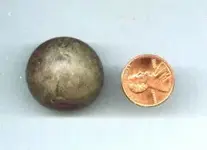A
am433am
Guest
- #1
Thread Owner
OK he res the story,,years ago i was digging bottles from a old well and i found this one old mustard bottle dates around (1900) with a round rock inside the top of the bottle had some type of metal on top and was sealed in wax..well i took the old rock out threw it in a junk box and there it sat for 20 years..well a few years ago me and a buddy was looking threw the junk box and found the rock..as we looked at it more closely we started thinging it was metal..so i gr abed my trusted heath kit metal detector and wow it is metal..so we started home tested it ( Drunk hillbilly style ) we tried scratching it,,nothing,,we put it under a drill press,,broke the bit,,,well a few more beers later,,we gr abed a blow torch,,after about 5 minutes it started to get a little warm...so them we gr abed a sledge hammer and whacked it more than a few times,,,,nothing...also found out in the process its non magnetic..so after a few more years in the box i took to a local rock hound he tested it for gold,,silver,,platinum..stainless steel,,garden rock...he was stumped,,he wanted me to let him hold it for a few weeks to test more i said no maybe another time back in the box it sits,,anyone have a clue ?
?
 ?
?




